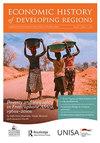Mild Arabica coffee trade at a time of market regulation
IF 0.8
Q1 HISTORY
引用次数: 0
Abstract
ABSTRACTThis paper explores the dynamics of mild coffee trade during the term of the International Coffee Agreement, focusing on Costa Rica as a case study. We aimed to verify the influence of the agreement on coffee exports and understand its impact on the exports of high-quality coffee. To compare the influence of the coffee agreement on the trade performance of high-quality coffee producers with that of producers specializing in coffee of similar – or lower – quality, we also included exports of Brazilian coffee (low quality) and Colombian coffee (high quality) in the sample. We focused on analysing commodity trade agreements in the second half of the twentieth century and, simultaneously, on the drivers of coffee exports based on a gravity equation consistent with international trade models. Our findings allowed us to conclude that the International Coffee Agreement gave rise to few benefits for ‘Other Milds’ countries such as Costa Rica and greater benefits for ‘Colombian Milds’ countries such as Colombia, at least in its early versions.KEYWORDS: International Coffee Agreement (ICoA)commodities agreementscoffee marketcoffee trademarket regulationgravity equationJEL CODES: F13024Q 17Q18 AcknowledgementsAndrea Montero-Mora thanks the University of Costa Rica for the scholarship awarded between 2014 and 2018 to develop the doctoral. The authors thank the anonymous referees for their constructive contributions that significantly improved this paper.Disclosure statementNo potential conflict of interest was reported by the authors.Notes1 Following Lawless (Citation1995) and Cardello (Citation1995), we agree that quality is a multidimensional field of analysis that encompasses objective and subjective components and has a spatial and temporal framework. The concept refers to the degree of excellence of a specific product and the absence of defects covering sensory and other hidden aspects. The sensory characteristics (shape, texture, appearance, colour, and smell) are easily perceived by the senses, while the hidden ones (chemical composition) require measuring instruments and concern safety and nutrition (Shewfelt Citation1999). Quality can also be measured through other dimensions, such as the nutritional composition, the ease of preparation, the density of the product, or the reputation of the brands or origins, among other aspects (Lawless Citation1995). In addition, for each of the actors involved in the production and marketing of a product chain, quality can have different meanings or connotations. Producers usually define it in sensory and hidden information terms, while consumers provide their perception of their satisfaction, thus showing a less tangible and less quantifiable aspect (Shewfelt Citation1999; Samper Citation2002, Citation2003; Viales and Montero Citation2015).2 In specification (2) we do not consider pair interactions allowing us to introduce distance and other control variables associated with geography in the regression results.温和的阿拉比卡咖啡在市场调控时期进行贸易
摘要本文以哥斯达黎加为例,探讨了国际咖啡协定期间淡咖啡贸易的动态。我们旨在验证该协议对咖啡出口的影响,了解其对高品质咖啡出口的影响。为了比较咖啡协议对高质量咖啡生产商与专门生产类似或较低质量咖啡的生产商的贸易绩效的影响,我们还在样本中包括了巴西咖啡(低质量)和哥伦比亚咖啡(高质量)的出口。我们重点分析了20世纪下半叶的商品贸易协定,同时,基于与国际贸易模型一致的重力方程,分析了咖啡出口的驱动因素。我们的研究结果使我们得出结论,国际咖啡协议对哥斯达黎加等“其他温和”国家的好处很少,而对哥伦比亚等“哥伦比亚温和”国家的好处更大,至少在其早期版本中是这样。关键词:国际咖啡协议(ICoA)商品协议;咖啡市场;咖啡贸易;市场监管;重力方程;jel代码:F13024Q 17Q18致谢;作者感谢匿名审稿人的建设性贡献,使本文得到了显著的改进。披露声明作者未报告潜在的利益冲突。注1继Lawless (Citation1995)和Cardello (Citation1995)之后,我们同意质量是一个多维分析领域,包括客观和主观成分,并具有空间和时间框架。这个概念是指特定产品的卓越程度,以及不存在包括感官和其他隐藏方面的缺陷。感官特征(形状、质地、外观、颜色和气味)很容易被感官感知,而隐藏的特征(化学成分)需要测量仪器,并且涉及安全性和营养(Shewfelt Citation1999)。质量也可以通过其他方面来衡量,比如营养成分、制备的难易程度、产品的密度、品牌或原产地的声誉,以及其他方面(Lawless citation, 1995)。此外,对于参与产品链生产和营销的每个参与者,质量可以具有不同的含义或内涵。生产者通常用感官和隐藏信息术语来定义它,而消费者则提供他们对满意度的感知,从而显示出不太有形和不太可量化的方面(Shewfelt Citation1999;Samper Citation2002, Citation2003;Viales and Montero引文,2015)2在规范(2)中,我们没有考虑对相互作用,允许我们在回归结果中引入距离和其他与地理相关的控制变量。
本文章由计算机程序翻译,如有差异,请以英文原文为准。
求助全文
约1分钟内获得全文
求助全文

 求助内容:
求助内容: 应助结果提醒方式:
应助结果提醒方式:


